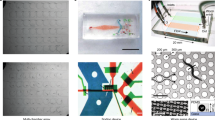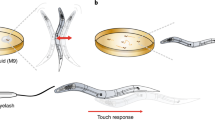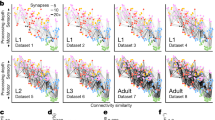Key Points
-
The nematode worm Caenorhabitis elegans is ideal as a model organism for scientific research owing to its simplicity and arsenal of available tools. New technologies increase the usefulness of the worm as a model.
-
Loss-of-function experiments used to rely on untargeted mutagenesis techniques, such as chemical or transposon-based mutagenesis. Recent techniques allow for targeted mutagenesis using Mos-transposon-directed or zinc finger nuclease (ZFN)- or transcription activator-like effector nuclease (TALEN)-site-directed mutagenesis.
-
Loss-of-function experiments using RNAi have been refined so that knockdown only occurs in a tissue of interest rather than in the whole body.
-
Gain-of-function experiments have been improved in multiple facets by recent developments: recombineering technology and a fosmid DNA library have facilitated the generation and modification of DNA constructions, Mos transposition has allowed for single-copy insertion of a transgene into a defined locus, and using antibiotics as a selection marker has made it easier to screen for positive transgenesis events.
-
Gain-of-function experiments have been enhanced by the introduction of the FLP–FRT (flippase and flippase recognition target) system for inducible gene expression. In combination with other inducible systems, such as Cre–loxP and the heat shock promoter, FLP–FRT should allow for more refined control over gene expression.
-
Flow-cytometry technology can be used to ameliorate difficult or labour-intensive processes, including sorting synchronous-stage embryos and screening for genetic mutants.
-
Microfluidic technology can semi-automate procedures that require considerable labour or precision. Recent developments use microfluidic setups in order to semi-automate lifespan analysis and neurosurgery.
-
Imaging techniques have allowed for studies on the level of single cells or single molecules. Recent developments include methods to quantify gene expression in single cells, trace expression through cellular lineages during embryogenesis and detect single mRNA molecules in single cells.
-
Optogenetics, a method that uses light to activate or inactivate specific neurons, is ideally suited for C. elegans owing to the worm's transparent body and fairly simple nervous system of only 302 neurons. Recent methods that allow for optogenetics in freely moving worms permit the examination of the neural networks underlying movement and other behaviours, which could not be examined in immobilized worms.
Abstract
The inherent simplicity of Caenorhabditis elegans and its extensive genetic toolkit make it ideal for studying complex biological processes. Recent developments further increase the usefulness of the worm, including new methods for: altering gene expression, altering physiology using optogenetics, manipulating large numbers of worms, automating laborious processes and processing high-resolution images. These developments both enhance the worm as a model for studying processes such as development and ageing and make it an attractive model in areas such as neurobiology and behaviour.
This is a preview of subscription content, access via your institution
Access options
Subscribe to this journal
Receive 12 print issues and online access
$189.00 per year
only $15.75 per issue
Buy this article
- Purchase on Springer Link
- Instant access to full article PDF
Prices may be subject to local taxes which are calculated during checkout




Similar content being viewed by others
References
Kimble, J. & Hirsh, D. The postembryonic cell lineages of the hermaphrodite and male gonads in Caenorhabditis elegans. Dev. Biol. 70, 396–417 (1979).
Sulston, J. E. & Horvitz, H. R. Post-embryonic cell lineages of the nematode, Caenorhabditis elegans. Dev. Biol. 56, 110–156 (1977).
Sulston, J. E., Schierenberg, E., White, J. G. & Thomson, J. N. The embryonic cell lineage of the nematode Caenorhabditis elegans. Dev. Biol. 100, 64–119 (1983).
C. elegans Sequencing Consortium. Genome sequence of the nematode C. elegans: a platform for investigating biology. Science 282, 2012–2018 (1998).
Lai, C. H., Chou, C. Y., Ch'ang, L. Y., Liu, C. S. & Lin, W. Identification of novel human genes evolutionarily conserved in Caenorhabditis elegans by comparative proteomics. Genome Res. 10, 703–713 (2000).
Hulme, S. E. & Whitesides, G. M. Chemistry and the worm: Caenorhabditis elegans as a platform for integrating chemical and biological research. Angew. Chem. Int. Edn Engl. 50, 4774–4807 (2011).
Antoshechkin, I. & Sternberg, P. W. The versatile worm: genetic and genomic resources for Caenorhabditis elegans research. Nature Rev. Genet. 8, 518–532 (2007).
Van Nostrand, E. L. & Kim, S. K. Seeing elegance in the gene regulatory networks of the worm. Curr. Opin. Genet. Dev. 21, 1–10 (2011).
Flibotte, S. et al. Whole-genome profiling of mutagenesis in Caenorhabditis elegans. Genetics 185, 431–441 (2010).
Sarin, S. et al. Analysis of multiple ethyl methanesulfonate-mutagenized Caenorhabditis elegans strains by whole-genome sequencing. Genetics 185, 417–430 (2010).
Frokjaer-Jensen, C. et al. Targeted gene deletions in C. elegans using transposon excision. Nature Methods 7, 451–453 (2010).
Bazopoulou, D. & Tavernarakis, N. The NemaGENETAG initiative: large scale transposon insertion gene-tagging in Caenorhabditis elegans. Genetica 137, 39–46 (2009).
Kim, Y. G., Cha, J. & Chandrasegaran, S. Hybrid restriction enzymes: zinc finger fusions to Fok I cleavage domain. Proc. Natl Acad. Sci. USA 93, 1156–1160 (1996).
Boch, J. et al. Breaking the code of DNA binding specificity of TAL-type III effectors. Science 326, 1509–1512 (2009).
Moscou, M. J. & Bogdanove, A. J. A simple cipher governs DNA recognition by TAL effectors. Science 326, 1501 (2009).
Wood, A. J. et al. Targeted genome editing across species using ZFNs and TALENs. Science 333, 307 (2011). Although there are still major design and cost considerations, ZFN- and TALEN-mediated mutagenesis have the potential to revolutionize the way mutants are generated. This paper describes the first time such methods have been employed in C. elegans.
De Francesco, L. Move over ZFNs. Nature Biotech. 29, 681–684 (2011).
Fire, A. et al. Potent and specific genetic interference by double-stranded RNA in Caenorhabditis elegans. Nature 391, 806–811 (1998).
Kamath, R. S. & Ahringer, J. Genome-wide RNAi screening in Caenorhabditis elegans. Methods 30, 313–321 (2003).
Calixto, A., Chelur, D., Topalidou, I., Chen, X. & Chalfie, M. Enhanced neuronal RNAi in C. elegans using SID-1. Nature Methods 7, 554–559 (2010).
Qadota, H. et al. Establishment of a tissue-specific RNAi system in C. elegans. Gene 400, 166–173 (2007).
Mello, C. C., Kramer, J. M., Stinchcomb, D. & Ambros, V. Efficient gene transfer in C.elegans: extrachromosomal maintenance and integration of transforming sequences. EMBO J. 10, 3959–3970 (1991). A classic, this paper describes how to introduce DNA into worms via microinjection. Microinjection is still the most common way of generating transgenic worms today and is also the basis for some of the newer techniques described in this Review, such as Mos transposition and mutagenesis mediated by TALENs and ZFNs.
Praitis, V., Casey, E., Collar, D. & Austin, J. Creation of low-copy integrated transgenic lines in Caenorhabditis elegans. Genetics 157, 1217–1226 (2001).
Frokjaer-Jensen, C. et al. Single-copy insertion of transgenes in Caenorhabditis elegans. Nature Genet. 40, 1375–1383 (2008).
Macosko, E. Z. et al. A hub-and-spoke circuit drives pheromone attraction and social behaviour in C. elegans. Nature 458, 1171–1175 (2009).
Hoier, E. F., Mohler, W. A., Kim, S. K. & Hajnal, A. The Caenorhabditis elegans APC-related gene apr-1 is required for epithelial cell migration and Hox gene expression. Genes Dev. 14, 874–886 (2000).
Davis, M. W., Morton, J. J., Carroll, D. & Jorgensen, E. M. Gene activation using FLP recombinase in C. elegans. PLoS Genet. 4, e1000028 (2008).
Voutev, R. & Hubbard, E. J. A “FLP-Out” system for controlled gene expression in Caenorhabditis elegans. Genetics 180, 103–119 (2008).
Ezcurra, M., Tanizawa, Y., Swoboda, P. & Schafer, W. R. Food sensitizes C. elegans avoidance behaviours through acute dopamine signalling. EMBO J. 30, 1110–1122 (2011).
Sarov, M. et al. A recombineering pipeline for functional genomics applied to Caenorhabditis elegans. Nature Methods 3, 839–844 (2006).
Gerstein, M. B. et al. Integrative analysis of the Caenorhabditis elegans genome by the modENCODE project. Science 330, 1775–1787 (2010).
Giordano-Santini, R. et al. An antibiotic selection marker for nematode transgenesis. Nature Methods 7, 721–723 (2010).
Semple, J. I., Garcia-Verdugo, R. & Lehner, B. Rapid selection of transgenic C. elegans using antibiotic resistance. Nature Methods 7, 725–727 (2010).
Stoeckius, M. et al. Large-scale sorting of C. elegans embryos reveals the dynamics of small RNA expression. Nature Methods 6, 745–751 (2009).
Rea, S. L., Ventura, N. & Johnson, T. E. Relationship between mitochondrial electron transport chain dysfunction, development, and life extension in Caenorhabditis elegans. PLoS Biol. 5, e259 (2007).
Moy, T. I. et al. High-throughput screen for novel antimicrobials using a whole animal infection model. ACS Chem. Biol. 4, 527–533 (2009).
Doitsidou, M., Flames, N., Lee, A. C., Boyanov, A. & Hobert, O. Automated screening for mutants affecting dopaminergic-neuron specification in C. elegans. Nature Methods 5, 869–872 (2008). Genetic screens are a time-consuming and laborious process. This paper describes a method that would not only automate such processes, but is exquisite in its ability to detect even minute changes.
Hulme, S. E. et al. Lifespan-on-a-chip: microfluidic chambers for performing lifelong observation of C. elegans. Lab. Chip 10, 589–597 (2010).
Sanchez-Blanco, A. & Kim, S. K. Variable pathogenicity determines individual lifespan in Caenorhabditis elegans. PLoS Genet. 7, e1002047 (2011).
Samara, C. et al. Large-scale in vivo femtosecond laser neurosurgery screen reveals small-molecule enhancer of regeneration. Proc. Natl Acad. Sci. USA 107 (2010). Microfluidic technology has the potential to semi-automate many laborious processes in the laboratory. This paper presents one of the most elegant applications of microfluidics by converting the typically arduous process of neurosurgery into one that could be performed by a minimally trained user with ease, rapidity and precision.
Liu, X. et al. Analysis of cell fate from single-cell gene expression profiles in C. elegans. Cell 139, 623–633 (2009). Although the invariant cell lineage of the worm has been defined for over 30 years, expression analysis still tends towards descriptive characterizations of large tissues rather than quantitative characterizations of single cells. The method described in this paper allows for a minimally trained user to measure gene expression at a level of detail that was not previously thought possible without having committed to knowledge the entire cell lineage of the worm.
Peng, H., Long, F., Liu, X., Kim, S. K. & Myers, E. W. Straightening Caenorhabditis elegans images. Bioinformatics 24, 234–242 (2008).
Long, F., Peng, H., Liu, X., Kim, S. K. & Myers, G. Automatic recognition of cells (ARC) for 3D images of C. elegans. Lect. Notes Comp. Sci. 4955, 128–139 (2008).
Long, F., Peng, H., Liu, X., Kim, S. K. & Myers, E. A 3D digital atlas of C. elegans and its application to single-cell analyses. Nature Methods 6, 667–672 (2009).
Aydin, Z., Murray, J. I., Waterston, R. H. & Noble, W. S. Using machine learning to speed up manual image annotation: application to a 3D imaging protocol for measuring single cell gene expression in the developing C. elegans embryo. BMC Bioinformatics 11, 84 (2010).
Murray, J. I. et al. Automated analysis of embryonic gene expression with cellular resolution in C. elegans. Nature Methods 5, 703–709 (2008).
Raj, A., van den Bogaard, P., Rifkin, S. A., van Oudenaarden, A. & Tyagi, S. Imaging individual mRNA molecules using multiple singly labeled probes. Nature Methods 5, 877–879 (2008).
Raj, A., Rifkin, S. A., Andersen, E. & van Oudenaarden, A. Variability in gene expression underlies incomplete penetrance. Nature 463, 913–918 (2010).
Deisseroth, K. Optogenetics. Nature Methods 8, 26–29 (2011).
White, J. G., Southgate, E., Thomson, J. N. & Brenner, S. The structure of the nervous system of the nematode Caenorhabditis elegans. Phil. Trans. R. Soc. Lond. B 314, 1–340 (1986).
Hobert, O., Carrera, I. & Stefanakis, N. The molecular and gene regulatory signature of a neuron. Trends Neurosci. 33, 435–445 (2010).
Guo, Z. V., Hart, A. C. & Ramanathan, S. Optical interrogation of neural circuits in Caenorhabditis elegans. Nature Methods 6, 891–896 (2009).
Liu, Q., Hollopeter, G. & Jorgensen, E. M. Graded synaptic transmission at the Caenorhabditis elegans neuromuscular junction. Proc. Natl Acad. Sci. USA 106, 10823–10828 (2009).
Leifer, A. M., Fang-Yen, C., Gershow, M., Alkema, M. J. & Samuel, A. D. Optogenetic manipulation of neural activity in freely moving Caenorhabditis elegans. Nature Methods 8, 147–152 (2011).
Stirman, J. N. et al. Real-time multimodal optical control of neurons and muscles in freely behaving Caenorhabditis elegans. Nature Methods 8, 153–158 (2011). Optogenetics has transformed the field of neurobiology by allowing researchers to study real-time behavioural phenotypes resulting from the activation or inactivation of specific neurons. This paper is exciting not only because it uses optogenetics to address important research questions, but also because it makes optogenetics accessible to most research laboratories by demonstrating that the required tools can be built from a standard three-colour liquid crystal display (LCD) projector.
Brenner, S. The genetics of Caenorhabditis elegans. Genetics 77, 71–94 (1974).
Greenwald, I. lin-12, a nematode homeotic gene, is homologous to a set of mammalian proteins that includes epidermal growth factor. Cell 43, 583–590 (1985).
Sigurdson, D. C., Spanier, G. J. & Herman, R. K. Caenorhabditis elegans deficiency mapping. Genetics 108, 331–345 (1984).
Bacaj, T. & Shaham, S. Temporal control of cell-specific transgene expression in Caenorhabditis elegans. Genetics 176, 2651–2655 (2007).
Pulak, R. Techniques for analysis, sorting, and dispensing of C. elegans on the COPAS flow-sorting system. Methods Mol. Biol. 351, 275–286 (2006).
Gray, J. M. et al. Oxygen sensation and social feeding mediated by a C. elegans guanylate cyclase homologue. Nature 430, 317–322 (2004).
Nagel, G. et al. Light activation of channelrhodopsin-2 in excitable cells of Caenorhabditis elegans triggers rapid behavioral responses. Curr. Biol. 15, 2279–2284 (2005).
Acknowledgements
We thank members of the worm research community and apologize for the numerous works we could not cite owing to space limitations. We thank D. Sagi, M. Schvarzstein and members of the Kim laboratory for helpful discussion. We thank A. Sánchez-Blanco, A. Friedland and the anonymous reviewers for their suggestions and improvements and for their critical reading of the manuscript. X.X. is supported by the Cancer Biology Training Grant at Stanford University, California, USA. Research in the laboratory of S.K.K. is supported by the US National Human Genome Research Institute, the US National Institute of General Medical Sciences, the US National Institute on Aging and the Glenn Foundation.
Author information
Authors and Affiliations
Corresponding author
Ethics declarations
Competing interests
The authors declare no competing financial interests.
Glossary
- Biolistic bombardment
-
A technique for delivering nucleic acids into the cells, in which small metal particles coated with nucleic acid are fired into the target tissue under high pressure.
- Recombineering
-
Molecular genetic engineering technique that uses homologous recombination to manipulate and/or alter DNA.
- Fosmid
-
A low-copy vector for the construction of stable genomic libraries that uses the Escherichia coli F factor origin for replication. Each fosmid can store ~40 kb of library DNA, and these sequences are more stable in fosmids than in multi-copy vectors.
- Florescence-activated cell sorting
-
(FACS). An experimental technology that can separate cells by their fluorescence and light-scattering properties.
- Fluorescent in situ hybridization
-
(FISH). A microscopic technique that uses fluorescently tagged DNA probes to detect the cytological localization of specific RNA by in situ hybridization.
Rights and permissions
About this article
Cite this article
Xu, X., Kim, S. The early bird catches the worm: new technologies for the Caenorhabditis elegans toolkit. Nat Rev Genet 12, 793–801 (2011). https://doi.org/10.1038/nrg3050
Published:
Issue Date:
DOI: https://doi.org/10.1038/nrg3050
This article is cited by
-
Environmental stresses induce transgenerationally inheritable survival advantages via germline-to-soma communication in Caenorhabditis elegans
Nature Communications (2017)
-
Pharyngeal pumping in Caenorhabditis elegans depends on tonic and phasic signaling from the nervous system
Scientific Reports (2016)
-
Nematodes ultrastructure: complex systems and processes
Journal of Parasitic Diseases (2016)
-
Optogenetic analyses of neuronal network function and synaptic transmission in Caenorhabditis elegans
e-Neuroforum (2014)



